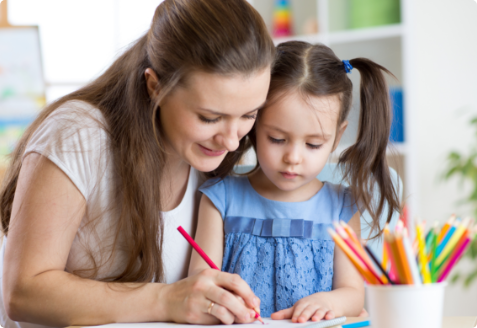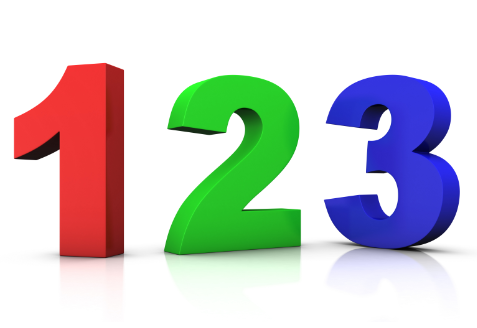Click on a concept below to try a sample question
Free, Printable Kindergarten Math
Worksheets for at-home Practice

Download this informative guide to learn how to best support your kindergartener as they learn and master important kindergarten math concepts.
Download Now 25+ Free Practice Worksheet questionsClick on a concept below to try a sample question
A stated objective of Common Core State Standards (CCSS) is to standardize academic guidelines nationwide. In other words, what kindergartners learn in math in one state should be the same as what students of the same age are learning in another state. The curricula may vary between these two states, but the general concepts behind them are similar. This approach is intended to replace wildly differing guidelines among different states, thus eliminating (in theory) inconsistent test scores and other metrics that gauge student success.
An increased focus on math would seem to include a wider variety of topics and concepts being taught at every grade level, including kindergarten. However, CCSS actually calls for fewer topics at each grade level. The Common Core approach (which is clearly influenced by “Singapore Math”—an educational initiative that promotes mastery instead of memorization) goes against many state standards. Many states mandate a “mile-wide, inch-deep” curriculum in which children are taught so much in a relatively short time span, that they aren’t effectively becoming proficient in the concepts they truly need to understand to succeed at the next level. Hence, CCSS works to establish an incredibly thorough foundation not only for the math concepts in future grades, but also toward practical application for a lifetime.
For kindergarten, Common Core’s focus is on developing an initial understanding of numbers, very basic addition and subtraction, and identifying shapes. Ultimately, this focus will enable children to develop rigor in real-life situations by achieving a base of conceptual understanding and procedural fluency.

Our kindergarten worksheets focus on helping students represent and compare whole numbers and describe shapes and space. CCSS has outlined these as two essential skills that Kindergarten students should have.
For many kindergartners, this year in school will offer their first math instruction beyond the basic counting they might have picked up at home or in preschool. As such, the emphasis will focus on how numbers work, in terms and methods easy for these new learners to understand. Here are the two critical areas that Common Core brings to kindergarten math:
 Representing and Comparing Whole Numbers
Representing and Comparing Whole Numbers
Kindergartners will write and use numbers to represent and solve quantities, such as how many of an object are in a set. Students will learn to compare numbers and get their first glimpse of simple equations (e.g., 2 + 3 = 5). They will also be taught basic adding and subtracting strategies—for example, that combining two sets of objects is addition and taking away objects from a set is subtraction.
 Describing Shapes and Space
Describing Shapes and Space
Students will learn to identify various two- and three-dimensional shapes, including circles, triangles, squares, cubes, and cylinders. They will also describe the physical world in terms of shapes, spatial relationships, and so on.

From the two critical areas of focus discussed in the previous section, Common Core also further clarifies the skills kindergartners should know by the end of the school year. For example, the fluency requirement at this level is adding and subtracting within 5. The five topics presented here, taken directly from CCSS itself, include some specifics on what kids will be taught in kindergarten.

 Counting and Cardinality
Counting and Cardinality
• Know the number names and count sequence. Kindergartners will learn to count to 100 by ones and by tens. They will be able to count starting from any number (not just 1) and learn to write numbers between 0 and 20.
• Count to tell the number of objects. This is exactly as it sounds: Students will become proficient in counting objects. They will be able to answer “how many” questions by counting up to 20 objects arranged in a line or array, and up to 10 objects scattered in a configuration (for example, “How many blue flowers are in this picture?”). Also, they will understand that the order or arrangement of objects doesn’t matter for counting.
• Compare numbers. Students will determine if one group of objects has more than, fewer than, or an equal amount compared with another group. They will also compare two numbers between 1 and 10 as written numerals.
 Operations and Algebraic Thinking
Operations and Algebraic Thinking
• Understand addition and subtraction. Students this age are at the beginning of more than a decade of math instruction. Adding and subtracting are the first operational steps of that journey. Among the concepts they will learn:


 Number Operations in Base 10
Number Operations in Base 10
• Work with numbers 11 to 19 to gain foundations for face value. Students will become proficient recognizing numbers between 11 and 19 and understanding that these numbers are composed of 10 ones plus another amount of ones (for example, 16 is 10 ones plus 6 ones, or 1 base ten block and 6 base one blocks).
 Measurement and Data
Measurement and Data
• Understand addition and subtraction. Students will learn the difference between height and weight (e.g., tall, short, light, heavy, big, small, and so on) and apply those attributes when describing and analyzing the characteristics of an object (for example, which pitcher will hold more water?). They will also compare measurements (for example, comparing two objects and describing which one is heavier, taller, smaller, and so on).
• Classify objects and count the number of objects in each category. The best way to explain this topic is to give an example: If a bowl has green, red, and yellow buttons, students will classify those objects into categories (such as color, size, shape), count how many there are of each, and sort those categories by number.


 Geometry
Geometry
• Identify and describe shapes. Kindergartners will learn the names of shapes, describe objects in relation to their positions (e.g., above, below, near, away, and so on), and describe if something is two-dimensional or three-dimensional.
•Analyze, create, compare, and compose shapes. Students will learn about, analyze, describe, and compare two- and three-dimensional shapes in terms of their characteristics (for example, a triangle has three sides) and size. They will also create shapes by drawing or building, and compose simple shapes into larger shapes (e.g., placing two squares together to get a rectangle).
Some of parents’ trepidation with Common Core isn’t so much with the guidelines themselves, but with the testing now aligned with CCSS via local math curricula. Standardized testing was stressful for students and parents before; with the ongoing Common Core implementation, many families simply don’t know what to expect.
Fortunately, CCSS does not have to be that stressful, for you or your kindergartner. Here are some tips to help your children succeed with Common Core math:

 Be informed; be involved
Be informed; be involved
If Common Core concerns you, intrigues you, or confuses you, don’t hesitate to learn as much about it—in your child’s classroom, at your kids’ school, and on a national level. Talk with teachers, principals, and other parents. Seek advice on how you can help your kids, and yourself, navigate CCSS math. If you want to take further action, become involved with PTA or other organizations and committees that deal with your school’s curriculum. The more you know, the more, ultimately, you can help your child.
 Live them some real-world math
Live them some real-world math
A basic tenet of Common Core is to apply math principles to real-world situations. Why not start now? Give your child math problems when you are out and about—the store, in traffic, the park, and so on. For example, if you are at a stoplight, challenge your kindergartner to count how many cars cross ahead of you; during rush hour, that number can reach well into double digits.
 Take time to learn what they are learning
Take time to learn what they are learning
You might look at a worksheet your child brings home and think, “This isn’t the math I’m used to.” Because Common Core emphasizes understanding the process of arriving at an answer, your child may be taught additional ways to fry a mathematical egg, so to speak. Instead of shunning these approaches, learn them for yourself. Once you comprehend these additional methods, you will be better able to help your child comprehend them as well.
 Encourage them to show their work
Encourage them to show their work
This suggestion can be read two ways. First, students will be encouraged to show how they arrived at an answer, especially within Common Core. Second, ask your children to show you their homework, particularly the challenging stuff. Explaining how a problem is solved is a basic CCSS tenet, so if your kids can be confident in explaining their work to you, they will carry that confidence into the classroom when the teacher asks for those same explanations.
 Seek more help if necessary
Seek more help if necessary
If your kindergartner is struggling with the new math standards, talk with his or her teacher first. You then might want to seek outside resources to help your child. Several online resources provide math help, including worksheets and sample tests that conform to Common Core standards. Tutoring might be an option you consider as well. Innovative iPad-based math programs have emerged that combine the personalized approach of a tutor with today’s technology. This revolutionary approach also may feature a curriculum based on Common Core, thus ensuring your child’s learning at home is aligned with what he or she is learning at school.
See up to a 90% Improvement in Math Scores Within 3 Months.
Start 7-Day Free Trial